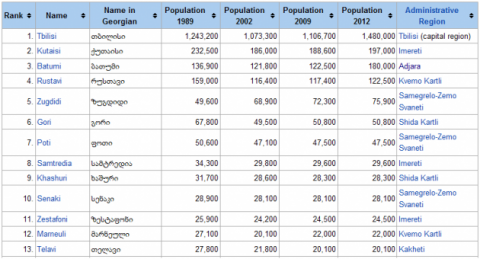 02
July
2024
02
July
2024
ISET Economist Blog
 Thursday,
11
April,
2013
Thursday,
11
April,
2013

 Thursday,
11
April,
2013
Thursday,
11
April,
2013
Please find below a chart with the population data of the 13 Georgian real urban settlements (I.e. plus 20,000 inhabitants).
As you can see, and contrary to widespread perceptions, there is no significant augmentation of the urban areas' population in Georgia in the last two decades or so. On the contrary, virtually all cities, except Tbilisi, saw a population decline, in many cases, with a 20% or more population lost (Kutaisi, Rustavi, Gori). the only exceptions are Zugdidi (certainly due to IDPs influx in the early '90s) and Batumi, which saw a boom (50% population increase) since 2009.

In the case of Tbilisi, the city is growing at a high speed in the last few years, although the loss in the 90s was so high that the total population now is actually just 20% more than 23 years ago - a very little increase compare to most capitals in the World.
These figures are hardly compatible with the common perception that there is a strong rural to urban areas migration in Georgia. Even the population growth in Tbilisi is likely based as much on migration for rural areas as from smaller cities such as Kutaisi or Gori.
Actually, someone might argue that the reason why statistics do not prove an increase in urban population despite the migration to cities by the villagers is that, although lots of people are supposedly migrating from the countryside to the cities, in parallel many urbanites migrate abroad, so there is a kind of population transfer taking place.
I would not agree with such a view: In Georgia, both villagers and urbanites are prompt to migrate abroad. For instance, ethnic Armenians from the south of the country saw probably the highest migration rates in the whole of Georgia, and they are mainly from rural areas; another example case: most of the Georgians in Barcelona (30,000) are from the (extremely rural) Lentekhi district. Thus, migration to other countries cannot be used as an 'excuse' to justify the decline of the urban population despite a supposedly dramatic influx of peasants to main towns.
The idea that most rural areas in Georgia are largely abandoned (which is actually the reason why people tend to think that rural folks are all moving to cities) is based on a misconception. This is certainly the case for certain districts of the country, especially in the highlands of the North Caucasus, such as most of Racha, Khevi, etc. These are, indeed, the areas where most of the foreigners and also many Tblisians travel during holidays. But for many other regions, normally not visited by the tourists such as the density populated lowlands of West Georgia, the hills of Adjara, the overcrowded fertile lands along the Alazani river, etc. most of the villages and small towns are as populated as they have always been. And it neither true that most old people live in rural settlements. Actually, the population pyramid in villages and cities in Georgia is almost the same.
These misconceptions are quite dangerous because they perpetuate the traditional ignorance and disregard of rural Georgia by Georgian urbanites.
Much of the fellow Georgian villagers are still there, in numbers of several hundreds of thousands waiting for a better life, but not always that prompt to move to the cities.





